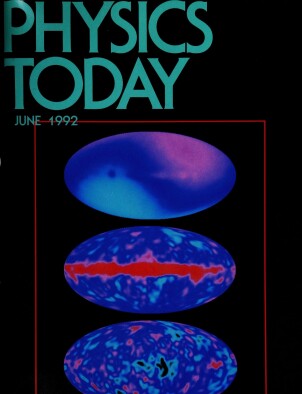Mapping Dark Matter with Gravitational Lenses
DOI: 10.1063/1.881309
Through the long‐range force of gravity, mass controls the evolution of the universe. Studies of the internal motion of large, gravitationally bound systems such as galaxies and clusters of galaxies have already shown us, rather convincingly, that the mass in these systems is dominated by some form of matter that is not luminous at any wavelength from radio to x ray. (See the article by Scott Tremaine in
This article is only available in PDF format
References
1. R. G. Kron, Vistas Astron. 26, 37 (1982). https://doi.org/VASTA6
J. F. Jarvis, J. A. Tyson, Astron. J. 86, 476 (1981).https://doi.org/ANJOAA2. J. A. Tyson, in CCDs in Astronomy, G. Jacoby, ed., Astron. Soc. Pacific, San Francisco (1990), p. 1.
3. J. A. Tyson, Astron. J. 96, 1 (1988).https://doi.org/ANJOAA
4. P. Guhathakurta, J. A. Tyson, S. Majewski, Astrophys. J. 357, L19 (1990).https://doi.org/ASJOAB
5. F. Zwicky, Phys. Rev. Lett. 51, 290 (1937).
6. E. L. Turner, J. P. Ostriker, J. R. Gott, Astrophys. J. 284, 1 (1984).https://doi.org/ASJOAB
7. G. Hinshaw, L. M. Krauss, Astrophys. J. 320, 468 (1987).https://doi.org/ASJOAB
8. W. Press, J. E. Gunn, Astrophys. J. 185, 397 (1973). https://doi.org/ASJOAB
See also J. E. Gunn, Astrophys. J. 147, 61 (1967); https://doi.org/ASJOAB
J. E. Gunn, 150, 737 (1967).9. D. Walsh, R. F. Carswell, R. J. Weymann, Nature 279, 381 (1979).
10. C. Kochanek, Astrophys. J. 375, 492 (1991).https://doi.org/ASJOAB
11. J. A. Tyson, F. Valdes, J. F. Jarvis, A. P. Mills, Astrophys. J. 281, L59 (1984).https://doi.org/ASJOAB
12. A. Hoag, Bull. Am. Astron. Soc. 13, 799 (1981).https://doi.org/AASBAR
13. R. Lynds, V. Petrosian, Bull. Am. Astron. Soc. 18, 1014 (1986); https://doi.org/AASBAR
R. Lynds, V. Petrosian, Astrophys. J. 336, 1 (1989). https://doi.org/ASJOAB
G. Soucail, Y. Mellier, B. Fort, F. Hammer, G. Mathez, Astron. Astrophys. 184, L9 (1987). https://doi.org/AAEJAF
G. Soucail, Y. Mellier, B. Fort, G. Mathez, M. Cailloux, Astron. Astrophys. 191, L19 (1988).https://doi.org/AAEJAF14. T. Noonan, Astron. J. 76, 765 (1971). https://doi.org/ANJOAA
R. D. Blandford, R. Narayan, Astrophys. J. 310, 568 (1986). https://doi.org/ASJOAB
R. D. Blandford, E. S. Phinney, R. Narayan, Astrophys. J. 313, 28 (1987). https://doi.org/ASJOAB
B. P. Paczynski, Nature 325, 572 (1987). https://doi.org/NATUAS
S. A. Grossman, R. Narayan, Astrophys. J. 324, L37 (1988).https://doi.org/ASJOAB15. B. Fort, J. Prieur, G. Mathez, Y. Mellier, G. Soucail, Astron. Astrophys. 200, L17 (1988). https://doi.org/AAEJAF
Y. Mellier, G. Soucail, B. Fort, G. Mathez, Astron. Astrophys. 199, 13 (1988).https://doi.org/AAEJAF16. J. A. Tyson, F. Valdes, R. A. Wenk, Astrophys. J. 349, L1 (1990).
J. A. Tyson, in After the First Three Minutes, AIP Conf. Proc. 222, S. Holt, C. Bennett, V. Trimble, eds., AIP, New York (1991), p. 437.17. S. Tremaine, J. E. Gunn, Phys. Rev. Lett. 42, 407 (1979).https://doi.org/PRLTAO
18. F. Valdes, J. A. Tyson, J. F. Jarvis, Astrophys. J. 271, 431 (1983). https://doi.org/ASJOAB
J. Miralda‐Escude, Astrophys. J. 380, 1 (1991). https://doi.org/ASJOAB
R. D. Blandford, A. B. Saust, T. Brainerd, J. V. Villumsen, Mon. Not. R. Astron. Soc. 2451, 600 (1991).




